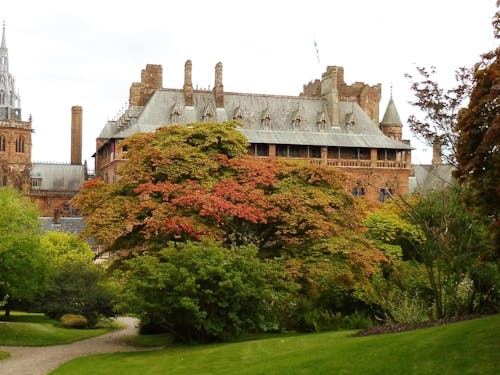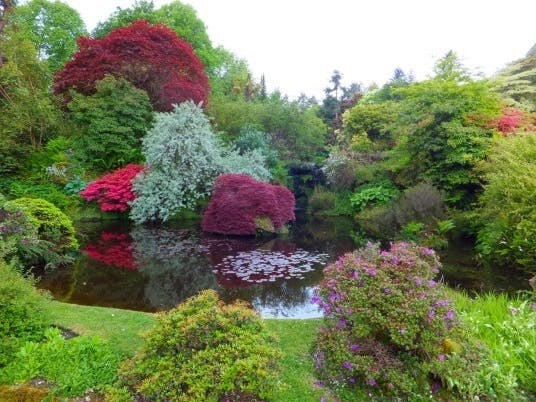
Mount Stuart House on the Isle of Bute is a dazzling showcase of Victorian Gothic architecture and a must-see for any island visitor. Here's a wee bit of background on the Crichton-Stuarts, the family for whom this 'Big Hoose' is their ancestral home.
The influence of Mount Stuart and the Marquess has evolved significantly since my childhood on Bute. In the 1970s, Mount Stuart owned nearly all the farms and much of the island's infrastructure, with its distinct mauve farm signage and vehicles being instantly recognisable. People spoke of the Marquess and "The Big Hoose" (as Mount Stuart was affectionately known) with genuine reverence. Over the years, however, this influence has waned for several reasons. Many who grew up during Mount Stuart's dominance have passed away; numerous farms and businesses have been sold off; the familiar mauve livery has vanished; and the island now hosts many newcomers who lack the same historical connection. Additionally, societies attitudes towards the aristocracy have become more relaxed. Despite these changes, locals remain immensely proud of Mount Stuart House and its significance in Scotland’s history, as well as their genuine affection for the late 7th Marquess of Bute.
The Stuart family, originally the Stewarts, has been connected to Bute for over six centuries. Their association began in the late 1400s when they assumed the title of Keepers of Rothesay. They initially resided in Rothesay Castle until its destruction during the Argyll Rising, after which they lived in a nearby manor house before Mount Stuart House became the family seat. Actually I think the Duke of Argyll may have done them a favour, as living in a draughty old stone castle can't have been pleasant.
Mount Stuart House was originally built in 1719, a Georgian style designed by the illustrious Edinburgh architect, Alexander McGill. It became home to the second Marquess of Bute, John Cricthton-Stuart (1793 – 1848). Notably, all the Marquesses are named John Crichton-Stuart, which must have been handy at functions if someone forgot their name.
In 1877, a fire ravaged Mount Stuart House, leaving only the wings intact. However, a redesign in 1872, featuring the beautiful Byzantine chapel, saw it rise like a phoenix from the ashes. This 19th century transformation was a collaboration between the third Marquess of Bute (1847 – 1900), the architect William Burgess and artist Horatio Walter Lonsdale, resulting in a fusion of gothic fantasy and modern technology. The eclectic design included mod cons, such as electric lighting, a passenger lift and the world’s first heated indoor swimming pool. These bold architectural extravagances reflected the eccentricities of the 3rd Marquess, who was at that time one of the richest men in the world – so he could afford a one or two little indulgences.
Stepping inside the house you find yourself surrounded by beauty. From the breathtaking stained-glass panels and celestial domed ceiling in the main hall, to the exquisite marble chapel. Taking time to admire the intricate carvings of birds, beasties and botanicals that adorn nearly every inch of woodwork.
Successive Marquesses contributed to diverse interests, such as architecture, ornithology, and the arts. The 4th Marquess (1881 – 1947) notably restored Caerphilly Castle, while the 5th Marquess (1907 – 1956) established St. Kilda as a bird sanctuary. The 6th Marquess (1933 – 1993) championed the arts and founded the Mount Stuart Trust.
The late 7th Marquess of Bute (1958 – 2021), fondly remembered as ‘Johnny Bute,’ championed the island's economy and community development, particularly through initiatives like the Bute Yard in Rothesay. Sadly, he passed away before its completion, but his legacy lives on through the collaborative efforts of his family, the Mount Stuart Trust, and local businesses, showcasing the island's vibrant produce and creativity for generations to come.
Mount Stuart House contains one of the most significant art collections in the British Isles, with over 600 paintings amassed over three centuries, and remarkably the collection has survived two house fires. While still privately owned by the current Marquess of Bute, the collection is managed by the Mount Stuart Trust. The family’s love of art is continued today with the Mount Stuart Trust promoting a variety of contemporary artists. An annual contemporary visual arts programme was founded in 2001 and the House and grounds have hosted several exhibitions.
Mount Stuart House sits within 300 acres of magnificent landscaped gardens and woodland. Much of which has recently undergone restoration, to reconstruct parts of the garden as it may have looked in its earlier years. The kitchen garden is now used to grow produce which is sold at local markets.
Mount Stuart House welcomes visitors for guided tours, which offer insights into its rich history. Explore the expansive grounds, which stretch from the shoreline to the surrounding woodland. Various events are held in the house and grounds throughout the year, ranging from a weekly Parkrun, Monthly Supper Clubs with their own chef, Easter Egg hunts, local Art & Craft Fairs to Vintage Tractor Runs.
Mount Stuart House also serves as a picturesque venue for private events and weddings. What a truly spectacular venue for a romantic wedding !!






